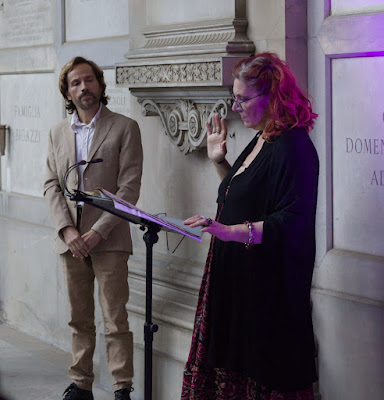
About the event

As part of the Certosa 2025 Summer Calendar, the Certosa Monumental Cemetery in Bologna, Italy, hosted the theatrical performance "Pen, Bread and Justice" (in Italian "Penna, Pane e Giustizia").
Produced by Associazione Rimacheride and directed by Giovanna Manfredini, the performance featured Luisa Vitali and Nicola Fabbri, with an original text by Giacomo Gailli. The play presented the stories of three important historical figures from Bologna, through which the values of equality, solidarity, and justice were reflected.
- 1878 – Gualberta Alaide Beccari, a Mazzinian and pioneering voice of the emancipation magazine La Donna, educated people about equality. Gender equality was her mission.
- 1914 – Francesco Zanardi, elected Mayor of Bologna on a socialist electoral programme focused on bread and literacy, is shown in a dialogue with a baker, symbolizing the everyday work that sustains community life.
- 1939 – Mario Finzi, a political and civil activist during the Second World War and founder of Delasem, built a network that helped save millions of Jews from extermination, illustrating that peace is built through solidarity and trust.
Peace, justice and strong institutions
The project was realized as part of the ASCE "Significant Cemeteries for Sustainable Europe" initiative, which included numerous activities during the Week of Discovering European Cemeteries (WDEC) and throughout the year. In 2025, it focused on peace, justice, and strong institutions—Goal 16 of the United Nations 2030 Agenda for Sustainable Development.
*Cover photo by Simone Bonetti, in-post photo by Giacomo Gailli.

















































